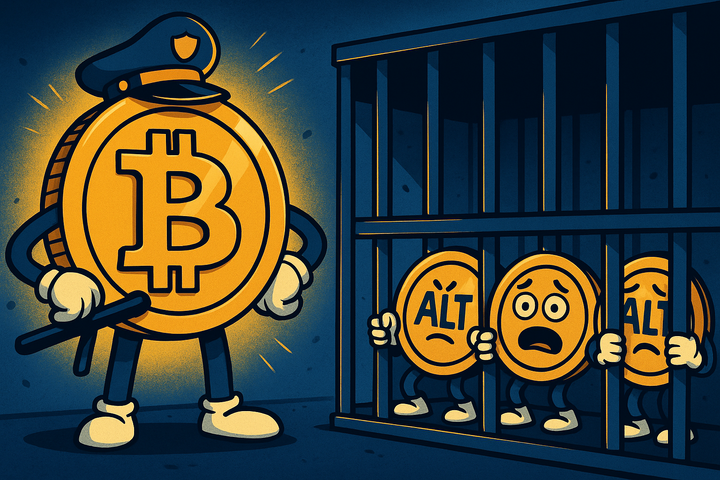Altcoin Glut Underscores Bitcoin’s Scarcity Edge
The April 24, 2025 episode of the Bitcoin for Millennials podcast features Jesse Myers explaining why Bitcoin’s fixed 21 million-coin limit makes it the lone digitally scarce asset.

- My 'briefing notes' summarize the content of podcast episodes; they do not reflect my own views.
- They contain (1) a summary of podcast content, (2) potential information gaps, and (3) some speculative views on wider Bitcoin implications.
- Pay attention to broadcast dates (I often summarize older episodes)
- Some episodes I summarize may be sponsored: don't trust, verify, if the information you are looking for is to be used for decision-making.
Summary
The April 24, 2025 episode of the Bitcoin for Millennials podcast features Jesse Myers explaining why Bitcoin’s fixed 21 million-coin limit makes it the lone digitally scarce asset. Myers shows that altcoin counts have exploded past 37 million, yet Bitcoin’s dominance has risen as most new tokens languish in illiquid “zombie” states. His argument positions Bitcoin as the protocol standard for digital value while highlighting regulatory, investment, and development implications.
Take-Home Messages
- Scarcity Advantage: A 37 million-token oversupply highlights Bitcoin’s unchangeable 21 million cap and attracts capital seeking reliability.
- Illiquidity Risk: Many tokens stall below meaningful volume, trapping holders and inflating headline market-cap figures.
- Metric Clarity: Removing stablecoins and zombie caps reveals Bitcoin’s effective dominance approaching 70 percent.
- Centralization Paradox: Altcoins require leadership and marketing, yet visible leaders undermine claims of decentralization.
- Policy Priority: Better disclosure and reserve rules are vital before altcoin failures transmit risk to traditional finance.
Overview
Jesse Myers opens by contrasting Bitcoin’s immutable supply with an altcoin universe that now tops 37 million tokens. He attributes the surge to near-zero launch costs enabled by tools like pump.fun, arguing that abundance eliminates scarcity narratives. The discussion frames Bitcoin as “digital gold” while describing altcoins as endlessly duplicable copies.
Myers then examines market data showing Bitcoin dominance rising since 2021 despite token proliferation. Stablecoins account for about ten percent of total value, masking Bitcoin’s true share of functional monetary assets. When those and illiquid coins are excluded, Bitcoin commands the vast majority of circulating, tradeable value.
Liquidity analysis reveals thousands of projects frozen below USD 100 000 in capitalization. These “zombie” tokens seldom trade, leaving retail investors unable to exit positions while founders and early backers move on. Myers notes that such stagnation fuels public distrust and invites regulatory scrutiny.
Finally, he presents the “crypto catch-22”: altcoins need aggressive marketing to gain traction, but that reliance on leadership destroys decentralization claims. New proof-of-work chains also face cheap 51 percent attacks from existing hardware, deterring serious competitors. Myers concludes that Bitcoin’s leaderless, head-start position resembles TCP/IP’s early victory in networking.
Stakeholder Perspectives
- Regulators: Press for clearer metrics and disclosures as illiquid tokens and stablecoins distort systemic-risk assessments.
- Retail Investors: Confront mounting losses from zombie tokens and seek reliable guidance amid narrative overload.
- Bitcoin Developers: Aim to redirect engineering talent from short-lived altcoin projects toward open-source Bitcoin infrastructure.
- Venture Capital Firms: Benefit from early token allocations yet face reputational damage as failure rates climb.
- Stablecoin Issuers: Operate in a regulatory gray zone that may soon tighten around reserve transparency and redemption guarantees.
Implications and Future Outlook
Altcoin oversupply is likely to hasten rules requiring liquidity audits, reserve proofs, and marketing-practice disclosures. Stronger oversight will expose many projects as unviable, concentrating value even further into Bitcoin and a handful of well-collateralized stablecoins. Policymakers who act early can reduce consumer harm and improve market transparency.
As speculative returns fade, developer resources and venture funding are expected to migrate toward Bitcoin-layer innovations such as payment channels, custody tools, and energy-optimization software. This shift could accelerate institutional integration and reinforce Bitcoin’s position as a settlement network. Talent redirection also reduces duplication, improving overall ecosystem resilience.
Financial institutions will increasingly treat Bitcoin as a strategic reserve asset once dominance metrics adjust for stablecoin noise. Early adopters may gain balance-sheet advantages similar to firms that first embraced internet protocols. Late adopters risk higher entry costs and competitive disadvantage in cross-border settlement efficiency.
Some Key Information Gaps
- How can analysts accurately measure Bitcoin dominance after excluding stablecoins? Precise metrics guide oversight priorities and improve systemic-risk models.
- Which governance models could reconcile marketing needs with genuine decentralization? An answer would inform protocol design and consumer-protection frameworks across open networks.
- What cost thresholds make 51 percent attacks economically unviable for new proof-of-work chains? Quantifying this barrier shapes security policy and future experimentation.
- What incentives could redirect developer talent from altcoin ventures to open-source Bitcoin work? Aligning talent with public-good infrastructure enhances long-term network resilience.
- What systemic risks do large stablecoin supplies pose to traditional banking liquidity? Clarifying these interactions helps regulators craft reserve and redemption standards.
Broader Implications for Bitcoin
Monetary Sovereignty Reimagined
Governments may need hybrid reserve strategies that blend Bitcoin with traditional assets as decentralized scarcity gains credibility. This shift could disrupt foreign-exchange regimes and force central banks to innovate surveillance tools. Long-term, monetary power may diffuse toward entities that embrace transparent, algorithmic supplies.
Developer Incentive Realignment
As altcoin narratives lose allure, high-value engineering talent is likely to pivot toward Bitcoin’s open-source stack. Concentrated expertise will accelerate improvements in scalability, privacy, and energy efficiency. The resulting network effects could widen the moat against late-stage competitors.
Retail Financial Literacy
Widespread recognition of zombie-token losses may catalyze demand for stronger financial-literacy programs. Educators and nonprofits that integrate Bitcoin’s scarcity principles into curricula can foster more informed investment behavior. Enhanced literacy reduces susceptibility to get-rich-quick narratives and promotes healthier capital formation.



Comments ()